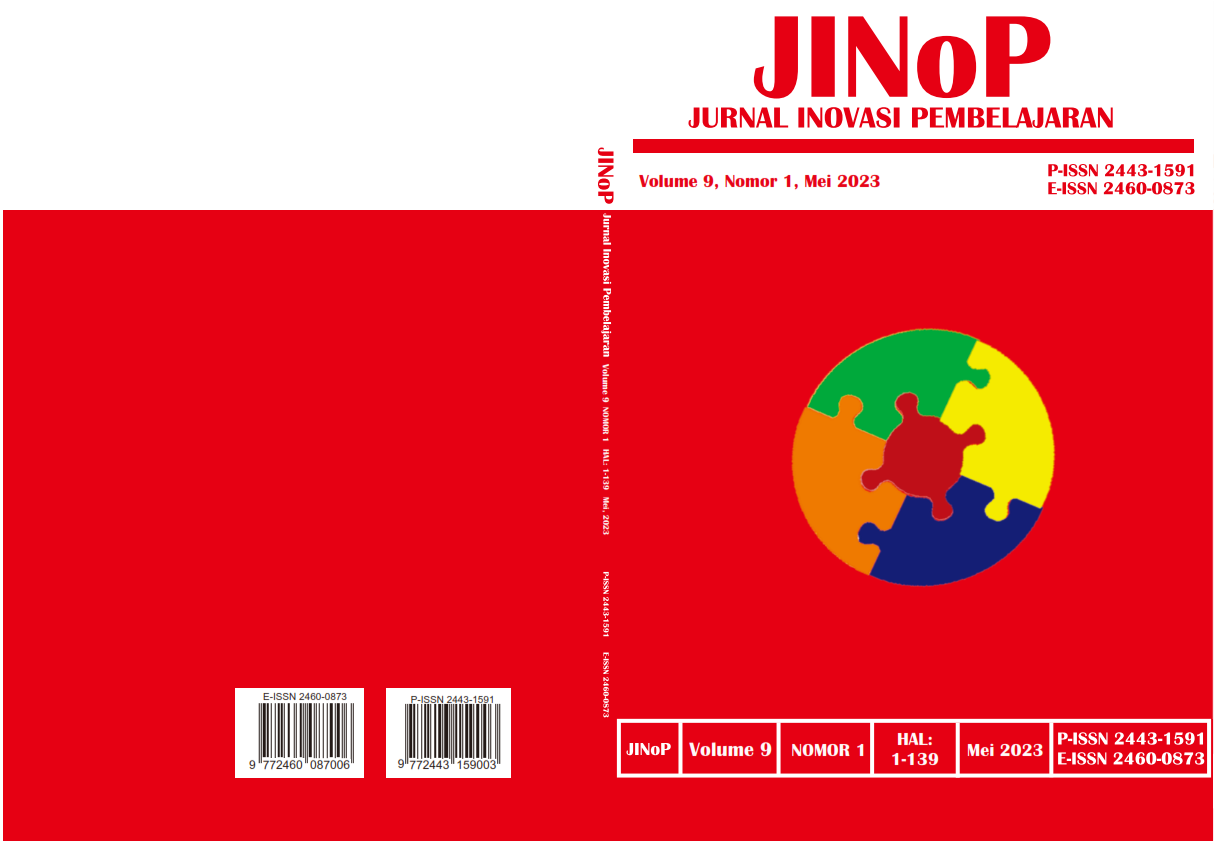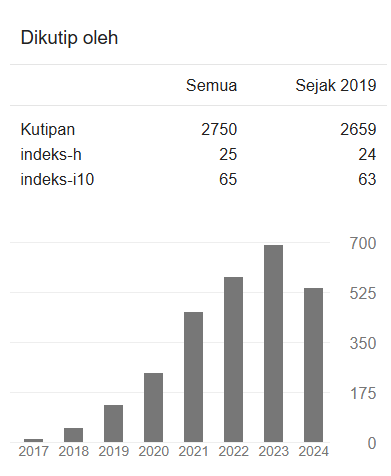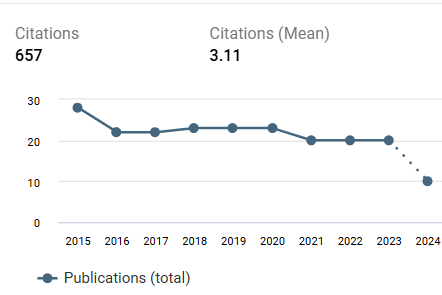The Implementasi Model PjBL-STEAM konteks lahan basah untuk meningkatkan kemampuan berpikir kritis dan self-efficacy peserta didik
DOI:
https://doi.org/10.22219/jinop.v9i1.23493Keywords:
Critical Thinking, Self-Efficacy, PjBL-STEAMAbstract
The PjBL-STEAM model of wetland contexts is a learning model that can improve students' critical thinking and self-efficacy skills. It is carried out by utilizing the wetland environment as a medium for learning electrolyte and nonelectrolyte solutions. This study aims to determine the improvement of students’ critical thinking and self-efficacy through the PjBL-STEAM model in the context of wetlands. This present study employed quasi-experimental experiment with a one-group pretest-posttest research design. The participants were obtained through convenient sampling with the inclusive criteria of students of class X MIA 3 at SMAN 3 Barabai. The data were obtained through critical thinking tests and self-efficacy questionnaires. The obtained data were analyzed through descriptive analysis. The results showed that the PjBL-STEAM model in the wetland context could improve the critical thinking ability and self-efficacy of students with an N-gain value of critical thinking ability of 0.58, with a moderate category and N-gain self-efficacy of 0.75 with a high category. In other words, applying the PjBL-STEAM model in wetland contexts effectively improves students' critical thinking and self-efficacy skills.
Downloads
References
Abdulah, I. (2020). Manajemen sarana prasarana dalam meningkatkan mutu pendidikan: Penelitian di Madrasah Aliyah Negeri 1 Garut dan Madrasah Aliyah Negeri 2 Garut. In Digilib UIN Sunan Gunung Djati. Digilib UIN Sunan Gunung Djati. http://digilib.uinsgd.ac.id/46543/1/Templet%20dan%20Model%20Pnul%20Prop%20Tesis%20dar%20RM%20Pdf2.pdf
Ahmad, D. A. (2020). Analisis Mengukur Kemampuan Berpikir Kritis Melalui Pembelajaran Menggunakan Metode STEAM-PjBL. In Prosiding Seminar Nasional dan Diskusi Panel Pendidikan Matematika Universitas Indraprasta PGRI. Universitas Indraprasta PGRI. http://www.proceeding.unindra.ac.id/index.php/DPNPMunindra/article/view/4755/747
Anderson, J. (2003). Critical Thinking Across the Disciplines. New York.
Arham, U. U., & Dwiningsih. (2016). K,, Keefektifan Multimedia Interaktif Berbasis Blender Learning Untuk Meningkatkan Hasil Belajar Peserta Didik. Kwangsan : Jurnal Teknologi Pendidikan, 4(2), 111–118. https://doi.org/10.31800/jtp.kw.v4n2.p111--118
Arikunto, S. (2010). Prosedur Penelitian Suatu Pendekatan Praktik. Rineka Cipta.
Bahari, F., & Yuliani. (2021). Pengembangan Permainan Ular Tangga pada Materi Pertumbuhan dan Perkembangan untuk Melatihkan Keterampilan Berpikir Kritis Siswa Kelas XII SMA. BioEdu, 10(3)), 617–626. https://doi.org/10.26740/bioedu.v10n3.p617-626
Bandura, A. (1997). Self-efficacy (W.H. Freeman and Company. (ed.)). W.H. Freeman and Company.
Baron, R. A. (2005). Psikologi Sosial (Edisi ke 10). Erlangga.
Chukwuyenum, A. N. (2017). Impact of Critical Thinking of Performance in Mathematics Among Senior Secondary School Stundent in Lagos State. Journal of Research & Metode in Education, 3(5), 18–25. https://d1wqtxts1xzle7.cloudfront.net/34729010/berpikir_kritis
DeJarnette, N. K. (2018). Implementing STEAM in the Early Childhood Classroom. 2018. European Journal of STEM Education, 3(3), 1–9. https://files.eric.ed.gov/fulltext/EJ1190735.pdf
Eichmann, B., Goldhammer, F., Greiff, S., & Pucite. (2019). The Role of Planning Incomplex Problem Solving. Computers and Education, 128(1), 1–12. https://www.sciencedirect.com/science/article/pii/S0360131518302082
Facione. P., A. 2010. Critical Thingking : What It Is and Why It Counts. Insight Assesment, 1-24.
Fitriyani, D., Rahmawati, Y., & Yusmaniar. (2019). Analisis Pemahaman Konsep Siswa pada Pembelajaran Larutan Elektrolit dan Non Elektrolit dengan 8E Learning Cycle. Jurnal Riset Pendidikan Kimia, 9(1), 30–40. https://doi.org/10.21009/JRPK.091.04
Ghufron, M. N. (2012). Gaya Belajar : Kajian Teoritik. Pustaka Belajar.
Hake, R. R. (1998). Interactive-engagement versus traditional methods : A six-thousand-student survey of mechanics test data for introductory physics courses. American Journal of Physics, 66(1), 64–74. https://doi.org/10.1119/1.18809
Kricsfalusy, V., George, C., & Reed, M. (2018). Integrating Problem- and Project-Based Learning Opportunities: Assessing Outcomes of a Field Course in Environment and Sustainability. Environmental Education Research, 24(4), 593–610. https://doi.org/10.1080/13504622.2016.1269874
Leonard., & Amanah. (2017). Pengaruh Advertisy Quotient (Aq) DAN Kemampuan Berpikir kritis terhadap Prestasi Belajar Matematika. https://journal.lppmunindra.ac.id/index.php.
Luzywati, L. (2017). Analisis Kemampuan Berpikir Kritis Siswa SMA Materi Alat Indera Melalui Model Pembelajaran Inquiry Pictorial Riddle. Pendidikan Sains & Matematika, 5, 2. https://e-journal.iain-palangkaraya.ac.id/index.php/edusains/article/view/732/766
Muti’ah. (2020). Analisis Kemampuan Berpikir Kritis dan Self-Efficacy Melalui Model Pembelajaran Creative Problem Solving Siswa Sekolah Menengah. Repositiry UNPAS. http://repository.unpas.ac.id/49880/
Priantari, I. P. (2020). Pembelajaran STEAM-PjBL untuk Peningkatan Berpikir Kritis. Bioeducation Journal, 4(2), 94–102. http://bioeducation.ppj.unp.ac.id/index.php/bioedu/
Rani, H. (2021). Penerapan Metode Project Based Learning pada Pembelajaran Sejarah Kebudayaan Islam dalam Meningkatkan Motivasi Belajar. REFLEKSI, 10(2), 95–101. https://p3i.my.id/index.php/refleksi/issue/view/44
Roosyanti, A. (2017). Pengembangan Perangkat Pembelajaran Berorientasi Pendekatan Guided Discovery untuk Melatihkan Keterampilan Berpikir Kritis dan Kreatif. Jurnal Pena Sains, 4, 1. https://d1wqtxts1xzle7.cloudfront.net/72193539/
Riduwan. 2012. Belajar Mudah Penelitian Untuk Guru, Karyawan, Peneliti, Pemula. Bandung : Alfabeta.
Sadirman, A. M. (1987). Motivasi dan Interaksi Belajar Mengajar. Rajawali Pers.
Samsudin, A. (2009). Berpikir Kritis. Retrieved from http://pendidikansains.blogspot.com/20009
Santi, E. (2022). Pendekatan STEAM pada Project Based Learning Mewujudkan Merdeka Belajar untuk Meningkatkan Kreativitas Siswa. Jurnal Pendidikan Dasar, 3(2), 76–80. https://jurnal.umpwr.ac.id/index.php/jpd/article/view/2240
Santika, I. (2021). Grand Design Kebijakan Strategis Pemerintah dalam Bidang Pendidikan untuk Menghadapi Revolusi Industri 4.0. Jurnal Education and Development, 9(2), 369–377. https://doi.org/10.37081/ed.v9i2.2500
Saputra, H. (2020). Kemampuan berfikir kritis matematis. Perpustakaan IAI Agus Salim, 2, 1–7.
Setyowati, A., Subali, B., & Mosik. (2011). Implementasi Pendekatan konflik dalam pembelajaran fisika untuk menumbuhkan kemampuan berpikir kritis siswa SMP kelas VII. In Jurnal Pendidikan Fisika Indonesia. https://journal.unnes.ac.id/nju/index.php/JPFI/article/view/1078/988
Sugiyono. (2013). Metode Penelitian Kuantitatif, Kualitatif, dan R&D. Alfabeta CV.
Undang-Undang Sistem Pendidikan Nasional (UURI No. 20 Tahun 2003 dan Peraturan Pelaksanaannya. 2003. Jakarta: Departemen Pendidikan Nasional.
Downloads
Published
How to Cite
Issue
Section
License
Copyright (c) 2023 Rusmansyah et al

This work is licensed under a Creative Commons Attribution 4.0 International License.
Copyright Notice
Authors who publish with JINoP (Jurnal Inoasi Pembelajaran) agree to the following terms:
- For all articles published in the JINoP (Jurnal Inovasi Pembelajaran), copyright is retained by the authors. Authors give permission to the publisher to announce the work with conditions. When the manuscript is accepted for publication, the authors agree to the automatic transfer of the publishing right to the publisher.
- Authors retain copyright and grant the journal the right of first publication with the work simultaneously licensed under a Creative Commons Attribution 4.0 International License. that allows others to share the work with an acknowledgment of the work's authorship and initial publication in this journal.
- Authors are able to enter into separate, additional contractual arrangements for the non-exclusive distribution of the journal's published version of the work (e.g., post it to an institutional repository or publish it in a book), with an acknowledgment of its initial publication in this journal.
- Authors are permitted and encouraged to post their work online (e.g., in institutional repositories or on their website) prior to and during the submission process, as it can lead to productive exchanges, as well as earlier and greater citation of published work (See The Effect of Open Access).








